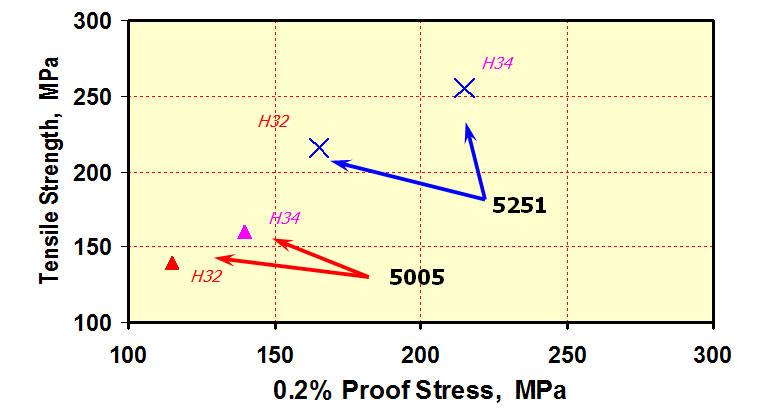Aluminium Alloy 5251
Aluminium 5251 UNS-A95251 |
Aluminium alloy 5251 contains nominally 2.0% magnesium & 0.30% manganese. It has good workability, medium static strength, high fatigue strength, good weldability, and very good corrosion resistance, especially in marine atmospheres. It also has the low density and excellent thermal conductivity common to all aluminium alloys. It is commonly used in sheet, plate and tube form. Typical Applications Architecture, general sheet metal work, small boats. View our complete guide to choosing an aluminium supplier. Chemical CompositionAluminium Development Council of Australia
Mechanical PropertiesAluminium Development Council of Australia
‡ Minimum elongation, actual value depends on thickness – thicker gauges have higher elongation
Key To Tempers
Description Aluminium 5251 is an aluminium magnesium manganese alloy which can be hardened by cold work: it is not heat treatable to higher strength. It is about mid way through the series of aluminium magnesium alloys for alloying content and strength, which is very similar to alloy 5052. Austral Wright Metals can supply this alloy as plate, sheet and strip. See Austral Wright Metals Catalogue for normal stock sizes and tempers. Corrosion Resistance 5251 has the same high resistance to general corrosion as other non heat treatable aluminium alloys. It also has the higher resistance to slightly alkaline conditions common to the 5000 series alloys. The resistance of 5251 to corrosion in marine atmospheres is excellent, exceeding that of 5005, hence the frequent use of 5251 in marine applications such as small boats and dinghies. The corrosion resistance of aluminium alloys relies on a protective surface oxide film, which when damaged is readily repaired by the rapid reaction between aluminium and oxygen. However, the high reactivity of the base metal can give rapid corrosion if the film cannot be repaired, so aluminium alloys are not suitable for use with reducing media. 5251 can be anodised to improve the corrosion resistance by thickening the protective surface film. Since aluminium is a reactive metal, it may corrode more quickly when in electrical contact with most other metals. The prediction of galvanic corrosion is complex; please consult Austral Wright Metals for specific advice. Pressure Vessels AS1210 Pressure Vessels and AS4041 Pressure Piping prequalify the alloy for pressure service for temperatures up to 200°C. Physical Properties
Fabrication Aluminium 5251 is not generally hot worked. It is very readily cold formable in the annealed condition, as it is ductile. Forming loads and tool & press wear are generally less than with carbon steel. For piercing and blanking the punch to die clearance should be about 7% of the thickness per side for the H32 & H34 tempers. Sharp tools are required. Indicative Minimum Bend Radiifor 90° cold forming for various thickness, t mm
Machinability 5251 is readily machinable by conventional methods. It should be machined at high speed with copious lubrication to avoid thermal distortion of the workpiece. Sharp tools are essential. High speed steel or tungsten carbide may be used. Cuts should be deep and continuous, with high cutting speeds. Woodworking machinery may be suitable for short runs. Heat Treatment Aluminium 5251 is annealed at 345°C, time at temperature and cooling rate are unimportant. Stress relief is rarely required, but can be carried out at about 220°C. If loss of strength is of concern, stress relief tests should be conducted. ASTM Product Specifications
Typical Strength of Alloys5005 & 5251 in the H32 & H34 tempers
| |||||||||||||||||||||||||||||||||||||||||||||||||||||||||||||||||||||||||||||||||||||||||||||||||||||||||||||||||||||||||||||||||||||||||||||||||||||||||||||||||||||||||||||||


